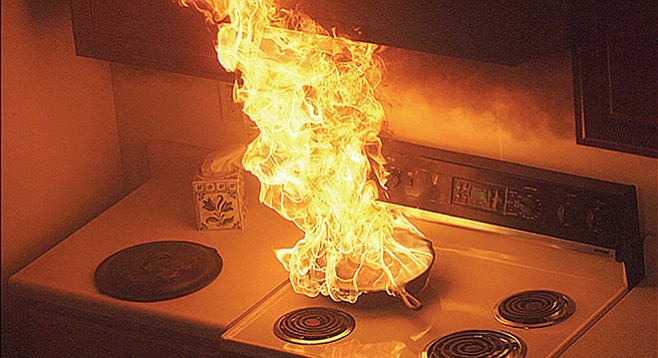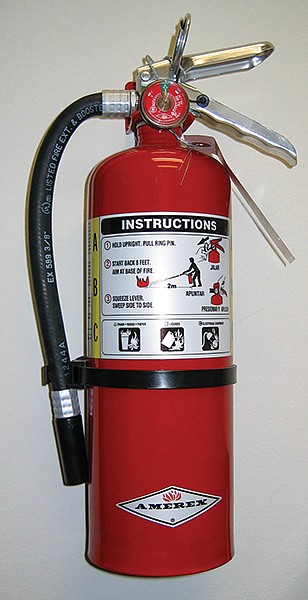 Facebook
Facebook
 X
X
 Instagram
Instagram
 TikTok
TikTok
 Youtube
Youtube

I managed to put out a grease fire in my kitchen this week by smothering it, but it got me spooked — and thinking about fire extinguishers.
Jari Wolfe is director of sales and chief of operations at SOCAL State Fire Protection (619-900-6910; socalfireservice.com). “We’re a mobile fire-safety service,” she explained. “We come out to homes, boats, and businesses. In my experience, about a third of people who want a fire extinguisher in their home want it for the kitchen because they cook a lot. The rest want them because of their hobbies. They work on classic cars and have oil cans lying around, or they have wood shops with lacquer in them — things that increase the risk of fire.”
For a hobby workshop, said Wolfe, “you might want an ABC dry chemical extinguisher [$39.87 for 2.5 lbs., $59.40 for 5 lbs., $89.99 for 10 lbs.]. That covers the most types. But sometimes, you want specific extinguishers for specific types of fires. Typically, for a kitchen, you get a K class extinguisher [$189.99, 2 liters]. The ‘k’ stands for ‘kitchen,’ and it’s designed for grease fires — animal fats and oils. If you have an electrical server room in your home, or if you run a lot of computers in one space in your home, you would want a halotron extinguisher [$137.50]. It’s filled with compressed argon gas, which dissipates, so there’s no dry chemical residue to corrode or destroy mechanical or electrical components. You’d also want one of those on a boat if you had an engine fire — a dry chemical extinguisher would destroy the engine. If you do welding, you may want a D class extinguisher [$455.59]. It has an extension application to keep the operator away from extreme heat.”
Wolfe told me that “as far as maintenance, it’s a good idea to get the extinguisher checked annually. We give you a call 30 days prior to the year’s expiration to schedule a visit [$29.99–$34.95, depending on distance].”
David Pulvers, owner of All County Fire in Normal Heights (619-284-4770; allcountyfire.com), offers mobile as well as walk-in service.

“We sell and recharge extinguishers; do fire-alarm maintenance, installation, and service; fire-hose sales and testing, fire-code compliance, emergency exit signals, and old extinguisher recycling.” He’s a big fan of home extinguishers, even though, he says, “I’m told by firefighters that the number of house fires is low. And we go out and recharge extinguishers every week. That means little fires are being put out with extinguishers so that the fire department doesn’t have to be called.” And even though “they’re not pretty, they should be kept in an easily accessible place near an exit. If your kitchen is adjacent to your garage, you could keep it just on the other side of the door.”
“If you’re going to have just one extinguisher,” said Pulvers, “get an ABC dry chemical, which discharges a silicon powder. ‘A’ stands for wood or ordinary combustibles, ‘B’ is for flammable liquids, and ‘C’ is electrical. Those are the main classes of fire. I’d say get a minimum of five pounds at $50–$60, but if you can handle bigger, get the ten-pound for $75–$85. You get so much more bang for your buck.”
Pulver also strongly suggests an “industrial-quality” extinguisher over “something you’d get at a Home Depot–type store. They’re made of superior materials, and the action of the handle is smoother. And we can replace parts on the industrial ones but not the consumer ones. Extinguishers need recharging every six years, and they cannot be recharged without changing out certain parts.” All County Fire charges $14 for in-store recharging,” and that covers an annual visual inspection as well. We check the weight, the pressure, and see if it has any dents. If it needs its 12-year pressure-test inspection, we’re able to do that as well.”
Before I left, Pulvers told me that, “another big part of what we do is fire-safety training. Businesses are required to have annual training in fire safety, and we’ll do both classroom work and a live fire test. We teach people the PASS method, which stands for pull the pin, aim, squeeze, and sweep. Once someone has put out a real fire, they realize that it’s not that difficult and they’re less intimidated.”


I managed to put out a grease fire in my kitchen this week by smothering it, but it got me spooked — and thinking about fire extinguishers.
Jari Wolfe is director of sales and chief of operations at SOCAL State Fire Protection (619-900-6910; socalfireservice.com). “We’re a mobile fire-safety service,” she explained. “We come out to homes, boats, and businesses. In my experience, about a third of people who want a fire extinguisher in their home want it for the kitchen because they cook a lot. The rest want them because of their hobbies. They work on classic cars and have oil cans lying around, or they have wood shops with lacquer in them — things that increase the risk of fire.”
For a hobby workshop, said Wolfe, “you might want an ABC dry chemical extinguisher [$39.87 for 2.5 lbs., $59.40 for 5 lbs., $89.99 for 10 lbs.]. That covers the most types. But sometimes, you want specific extinguishers for specific types of fires. Typically, for a kitchen, you get a K class extinguisher [$189.99, 2 liters]. The ‘k’ stands for ‘kitchen,’ and it’s designed for grease fires — animal fats and oils. If you have an electrical server room in your home, or if you run a lot of computers in one space in your home, you would want a halotron extinguisher [$137.50]. It’s filled with compressed argon gas, which dissipates, so there’s no dry chemical residue to corrode or destroy mechanical or electrical components. You’d also want one of those on a boat if you had an engine fire — a dry chemical extinguisher would destroy the engine. If you do welding, you may want a D class extinguisher [$455.59]. It has an extension application to keep the operator away from extreme heat.”
Wolfe told me that “as far as maintenance, it’s a good idea to get the extinguisher checked annually. We give you a call 30 days prior to the year’s expiration to schedule a visit [$29.99–$34.95, depending on distance].”
David Pulvers, owner of All County Fire in Normal Heights (619-284-4770; allcountyfire.com), offers mobile as well as walk-in service.

“We sell and recharge extinguishers; do fire-alarm maintenance, installation, and service; fire-hose sales and testing, fire-code compliance, emergency exit signals, and old extinguisher recycling.” He’s a big fan of home extinguishers, even though, he says, “I’m told by firefighters that the number of house fires is low. And we go out and recharge extinguishers every week. That means little fires are being put out with extinguishers so that the fire department doesn’t have to be called.” And even though “they’re not pretty, they should be kept in an easily accessible place near an exit. If your kitchen is adjacent to your garage, you could keep it just on the other side of the door.”
“If you’re going to have just one extinguisher,” said Pulvers, “get an ABC dry chemical, which discharges a silicon powder. ‘A’ stands for wood or ordinary combustibles, ‘B’ is for flammable liquids, and ‘C’ is electrical. Those are the main classes of fire. I’d say get a minimum of five pounds at $50–$60, but if you can handle bigger, get the ten-pound for $75–$85. You get so much more bang for your buck.”
Pulver also strongly suggests an “industrial-quality” extinguisher over “something you’d get at a Home Depot–type store. They’re made of superior materials, and the action of the handle is smoother. And we can replace parts on the industrial ones but not the consumer ones. Extinguishers need recharging every six years, and they cannot be recharged without changing out certain parts.” All County Fire charges $14 for in-store recharging,” and that covers an annual visual inspection as well. We check the weight, the pressure, and see if it has any dents. If it needs its 12-year pressure-test inspection, we’re able to do that as well.”
Before I left, Pulvers told me that, “another big part of what we do is fire-safety training. Businesses are required to have annual training in fire safety, and we’ll do both classroom work and a live fire test. We teach people the PASS method, which stands for pull the pin, aim, squeeze, and sweep. Once someone has put out a real fire, they realize that it’s not that difficult and they’re less intimidated.”
Comments